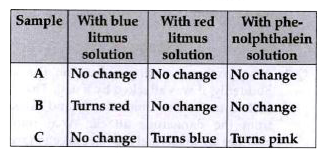You want to perform an experiment to study a double displacement reaction in your school laboratory. Name two aqueous solutions required for the experiment. Stare the colour change you are likdy to observe on mix- ing the two solutions.
For answer, consult Q. 10.
Topper's Solved these Questions
Similar Questions
You want to study a decomposition reaction by taking ferrous sulphate crystals in a boiling tube. List two steps you would follow while doing the experiment.
View SolutionPrepare aqueous solutions of various solid salts availble in the laboratory.Observe what happens when aqueos solution of sodium hydroxide is added to these. Prepare a chart of double displacement reactions based on these observations.
View Solution
Knowledge Check
A student was given two metal strips X and Y alongwith colourless nitrate solution to perform two separate displacement reactions. When the student placed metal strip X in nitrate solution for a considerable time he observed hat the solution turned blue and coating of silver meal was formed on the strip. And when the student immersed meal strip Y in silver nitrate solution for an equal time, the observed that the solution turned light green with the fomation of a coating of silver meal on the strip. The correct conclusion of the student about the identity of meals X and Y is:
AX is copper and Y is magnesiumBX is zinc and Y is copperCX is iron and Y is copperDX is copper and Y is ironYou are provided with aqueous solutions of three salts - A,B and C,2-3 drops of blue litmus solution, red litmus solution and phenophtanlein were added to each of these solution in separate experiment. The change in colour of different indicators were recorded in the following table :

On the basis of above observation, identify A,B, and C from the following options :AA=NH4CI,B=NaCI,C=CH3COONaBA=NH4CI,B=CH3COONa,C=NaCICA=NaCI,B=NH4CI,C=CH3COONaDA=CH3COONa,B=NH4CI,C=NaCI
Prepare aqueous solutions of various solid salts availble in the laboratory.Observe what happens when aqueos solution of sodium hydroxide is added to these. Prepare a chart of double displacement reactions based on these observations.
View SolutionA student addd few pieces of aluminium metal to two test tubes A and B containing aqueous solutions of iron sulphate and copper sulphate. In the second part of her experiment, the added iron metal to another test tubes C and D containing aqueous solutions of aluminium sulphate and copper sulphate.
In which test tube or test tubes will she observe colour change? On the basis of this experiment, state which one is the most reactive metal and why ?
View SolutionA student addd few pieces of aluminium metal to two test tubes A and B containing aqueous solutions of iron sulphate and copper sulphate. In the second part of her experiment, the added iron metal to another test tubes C and D containing aqueous solutions of aluminium sulphate and copper sulphate.
In which test tube or test tubes will she observe colour change? On the basis of this experiment, state which one is the most reactive metal and why ?
View SolutionAll the students of class 9 were performing experiments to study the types of solutions in the science laboratory. Vikalp took some water in a beaker and heated it slowly with the help of a burner.He starded adding postassium nitrate to the hot water with a spoon and stirred it with a glass rod continuously, so that potassium nitrate goes on dissolving in water. Vikalp took the temperature of water up to 40∘C, and then keeping the temperature constant, went on adding more and more of potassium nitrate to water, till no more potassium nitrate dissolved in it and some potassium nitrate is also left undissolved at the bottom of beaker. The contents of the beaker are now filtered through a filter paper arranged in a funnel. A clear solution is obtained in the form of a filtrate
(a) Depending upon the amount of solute present, the solution can be classified into two groups. Name these two groups of solution
(b) What type of potassium nitrate solution prepared by Vikalp at 40∘C ? Define the type of solution prepared by Vikalp
(c) What will happen if the potassium nitrate solution prepaerd by Vikalp at 40∘C ? is heated further (say to 60∘C) ? Give reason for your answer
(d) What will happen if the potassium nitrate solution prepared by Vikalp at 40∘C is allowed to cool (say to 20∘C) ? Give reason for your answer
(e) Which term/phrase can be used to convey that a maximum of 106 grams of potassium nitrate can be dissolved in 100 grams of water at a temperature of 60∘C ?
(f) What values are displayed by Vikalp in this episode ?
View SolutionManish was given aqueous solutions of silver nitrate, zinc sulphate and an iron nail. In the first experiment, he dipped iron nail in silver nitrate solution and observed that the solution turned brown. In second experiment, he dipped iron nail in zinc sulphate solution. However, no change was observed.
Based on the above information, answer the following questions.
Name the type of reaction that occurs when iron reacts with AgNO3 solution.
View SolutionManish was given aqueous solutions of silver nitrate, zinc sulphate and an iron nail. In the first experiment, he dipped iron nail in silver nitrate solution and observed that the solution turned brown. In second experiment, he dipped iron nail in zinc sulphate solution. However, no change was observed.
Based on the above information, answer the following questions.
Based on your observation, arrange Ag, Zn and Fe in decreasing order of their reactivity.
View Solution
